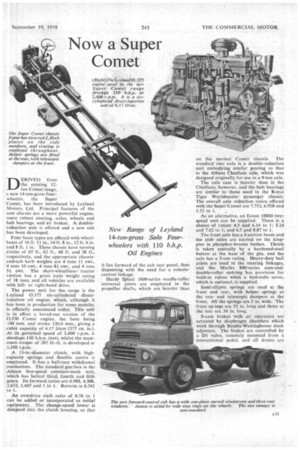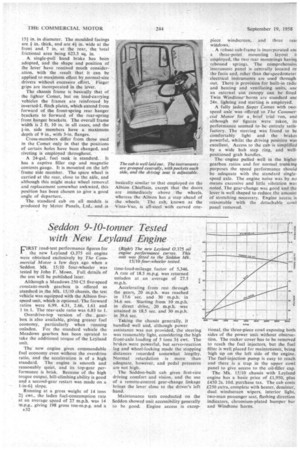Now a Super Comet
Page 121

Page 122

If you've noticed an error in this article please click here to report it so we can fix it.
New Range of Leyland 14-ton-gross Solo Fourwheelers with 110 b.h.p. Oil Engines
DERIVED from the existing 12ton Comet range, a new 14-ton-gross fourwheeler, the Super
Comet, has been introduced by Leyland Motors, Ltd. Principal features of the new chassis are a more powerful engine, more robust steering, axles, wheels and hub bearings, and air brakes. A doublereduction axle is offered and a new cab has been developed.
Four basic types are offered with wheelbases of 16 ft. 11 in., 14 ft. 8 in., 12 ft. 6 in. and 8 ft. 1 in. These chassis have turning circles of 65 ft., 62 ft., 48 ft. and 38 ft., respectively, and the appropriate chassis. and-cab kerb weights are 4 -tons 11 cwt., 4 tons 10 cwt., 4 tons 8I cwt., and 4 tons 51 cwt. The short-wheelbase' tractor version has a gross train weight rating of 18 tons, and all vehicles are available with leftor right-hand drive, The power unit for the range is the Leyland 0.375 six-cylindered directinjection oil engine, which, although it tas been in production for some months, • is officially announced today. This unit is in effect •a bored-out version of the 0350 Comet engine, the bore being 104 mm. and stroke 120.6 mm., giving a cubic capacity of 6.17 litres (377 Cu. in.). At its governed speed of 2,400 r.p.m. it • develops 110 b_h.p. (net), whilst the maxi. mum torque of 285 lb.-ft. is developed at • 1,100 r.p.m.
A 13-in.-diameter clutch, with higheapacity springs and flexible centre is employed. It has a ball-race withdrawal mechanism. The standard gearbox is the Albion five-speed constant-mesh unit, . which has helical third, fourth and fifth gears. Its forward ratios -are 6.988, 4.308, 2.655, 1.605 atad 1 to 1. Reverse is 6.343 to 1.
An overdrive sixth ratio of 0.76 to I can be added or incorporated as initial equipment. The change-speed tower is designed into the clutch housing, so that it lies forward of the cab rear panel, thus dispensing with the need for a remotecontrol linkage. Hardy SPicer 1600-series needle-roller universal joints are employed in the propeller shafts, which are heavier than on the normal Comet chassis. The standard rear axle is a double-reduction unit embodying similar gearing to that in the Albion Chieftain axle, which was designed originally for use in a 9-ton axle. The axle ease is heavier than in the Chieftain, however, and the hub bearings are similar to those used in the Royal Tiger Worldmaster passenger chassis. The overall axle reduction ratios offered with the Super Comet are 7.742,6.928 and 5.52 to 1.
As an alternative, an Eaton 18800 twospeed unit can be supplied. There is a choice of ratios: 4.5 and 6.14 to 1; 5.14 and 7.02 to 1; and 6.5 and 8.87 to 1.
The front axle has a 1-section beam and the stub axles are carried on the kingpins in phosphor-bronze bushes. Thrust is taken centrally by a hardened-steel button at the base of the pin, and the axle has a 5-ton rating. Heavy-duty ball joints are used in the steering linkages, and the Marles 800-series cam-anddouble-roller stetring has provision for built-in valves when a hydraulic servo, which is optional, is supplied.
Semi-elliptic springs are used at the front and rear. with helper springs at the rear and telescopic dampers at the front. All the springs are 3 in. wide. The front springs are 52 in. long and those at the rear are 54 in long.
S-cam brakes with air operation arc actuated by diaphragm chambers which work through Bendix-Westinghouse slack adjusters. The brakes are controlled by a D1 valve, remotely mounted from a conventional pedal, and all drums are 154 in. in diameter. The moulded facings are 4in. thick, and are 4+ in. wide at the front and. 7 in. at the rear, the 'total frictional area being 623.3 sq. in.
A single-pull hand brake has been adopted, and the shape and position of the lever have received much consideration, with the result that it can be applied to maximum effect by normal-size drivers without excessive effort. Finger grips are incorporated in the lever.
The chassis frame is basically that of the lighter Comet, but on load-carrying vehicles the frames are reinforced by inverted-L flitch plates, which extend from forward of the front-spring rear hanger brackets to forward of the rear-spring front hanger brackets. The overall frame width is 2 ft. 10 in. in all cases, and the +-in. side members have a maximum depth of 9 in., with 3-in. flanges.
Cross-members differ from those used in the Comet only in that the positions of certain boles have been changed, and riveting is employed throughout.
A 24-gal. fuel tank is standard. It has a captive filler cap and magnetic contents gauge. It is mounted on the left frame side member. The spare wheel is carried at the rear, close to the axle, and although this might make wheel removal and replacement somewhat awkward, this position has been chosen to give a good angle of departure.
The standard cab on all models is produced by Motor Panels, Ltd., • and is basically similar to that employed on the Albion Chieftain, except that the doors are immediately above the wheels, whereas the Albion has a step ahead of the wheels. The cab, known as the Vista-Vue, is all-steel with curved one piece windscreen, and three real windows.
A robust sub-frame is incorporated anc a three-point mounting layout
employed, the two rear mountings havinl rebound springs. The comprehensive instrument panel is centrally located or the facia and, other than the speedometer electrical instruments are used through. out. There is provision for built-in radic and heating and ventilating units, anc an external sun canopy can be fitted Twin Windfonehorns are standard and 24v. lighting and starting is employed.
A fully laden Super Comet with two speed axle was offered to The Commercial Motor for a. brief trial run, and although no figures were taken, its performance seemed to be entirely satisfactory. The steering was found to be comfortably light and the brakes powerful, whilst the driving position was excellent. Access to the cab is simplified by a wide hub step ring, and well
positioned grab handles.
The engine pulled well in the higher gearbox ratios and for normal .trunking purposes the speed performance should be adequate with the standard singlespeed axle. The engine noise was by no means excessive and little vibration was noted. The gear-change was good and the lever is well shaped to reduce the amount of stretching necessary. Engine access is reasonable with the detachable cowl panel removed.
















































































































































































































